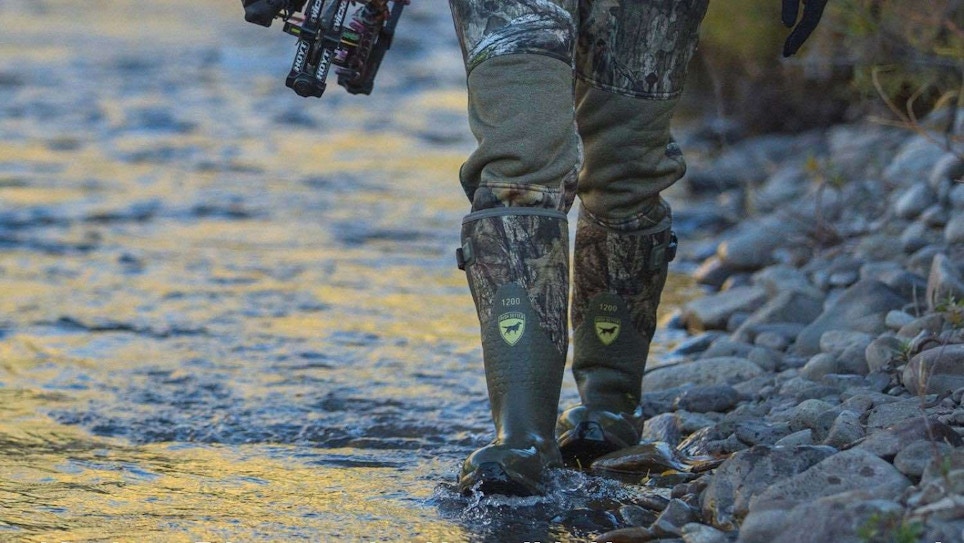During the 2022 whitetail season, I bowhunted South Dakota and Wisconsin, and because the seasons run from September through December, the temperatures vary greatly. This means my clothing and boot choices also vary greatly.
When it comes to hunting boots, I rely on knee-high rubber offerings 99 percent of the time. It’s only on those rare days when the temperature is more than 75 degrees that I’ll choose a lightweight pair of hiking boots.
I prefer bowhunting in knee-high rubber boots for five primary reasons:
- Dry feet. From morning dew to crossing shallow creeks and swamps, I need waterproof footwear. Period.
- Fewer wood ticks. During warm conditions, I end up with far fewer (often zero) wood ticks crawling on my clothing and skin when I wear knee-high rubber boots with pant legs tucked into the boots.
- Less on-the-ground scent. Assuming I keep my knee-high rubber boots clean and scent-free, I think I leave less on-the-ground scent while walking to and from my treestands and ground blinds. Do I leave some scent? Sure. But I think it’s less than if I’m wearing non-rubber hiking boots with my pants brushing up against grasses and other vegetation. Note: I spray the sides and bottom of my rubber boots with a scent-killing spray before hiking into a stand; I think it helps.
- Faster and cleaner. This might seem trivial, but I can slip into knee-high rubber boots (tucking my pant legs inside) in a second, maybe two. If I’m wearing tall leather hunting boots with laces, then I have to sit down and adjust the tension on the laces, then tie them. It’s a hassle and takes an extra minute or two every time I get ready to go hunting. And then when I return from the field, if I walked through water or mud, the laces are a mess.
- Easier to dry. Leather and other non-rubber boots are a pain to dry after they’re soaked with water or wet snow. With knee-high rubber boots, I simply place them on an inexpensive and efficient boot dryer and in a couple hours the insides are dry and toasty warm. The outsides are rubber so they dry almost instantly without any special care.
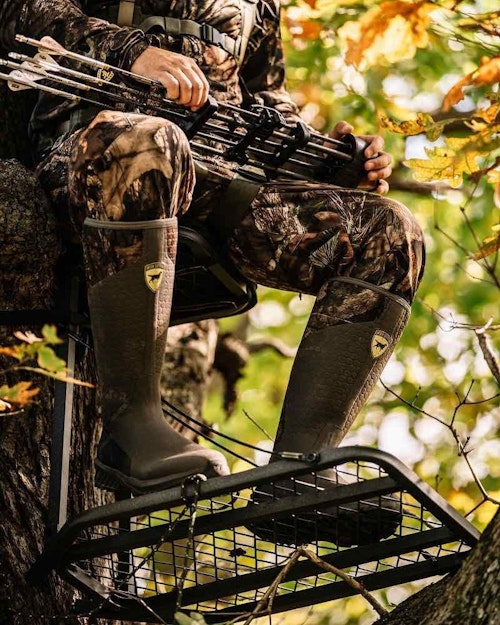
Irish Setter Mudtrek 4903 and 4904 — Two Models Combine for All Conditions
I’ve had excellent results with Irish Setter boots in the past — dating back to the mid-1990s — so I was excited to field test the new Mudtrek series in 2022. Click here and you’ll see what I mean by “series.” Irish Setter offers several Mudtrek versions, with differences in fit (full fit or athletic fit), height (15 inches or 17 inches), insulation (non-insulated, 800 gram, or 1,200 gram), and color (solids or camo).
I wanted to test Mudtrek boots throughout the entire deer season, so I chose one non-insulated pair — model 4903 — and one insulated pair — model 4904. The two versions have a lot in common, but some important differences, too. Because I began my archery season with model 4903, I’ll provide my feedback on them first.
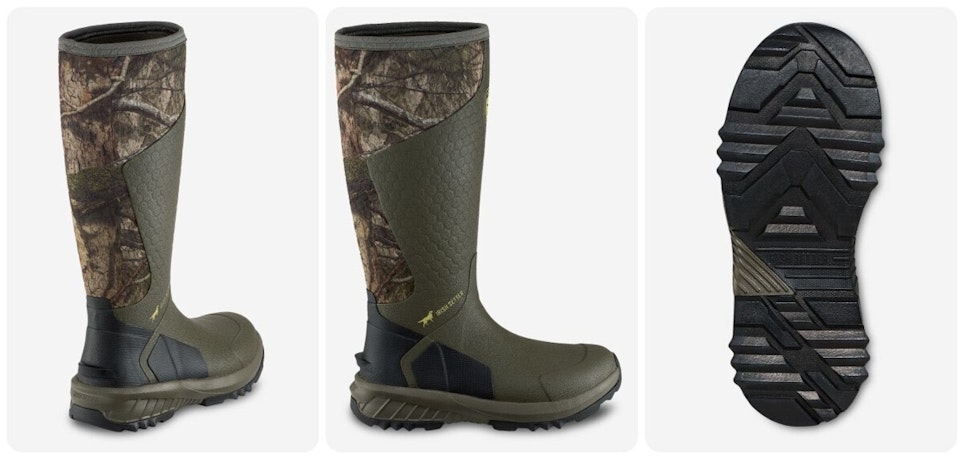
The Mudtrek 4903 (MSRP: $189.99) is a non-insulated, waterproof, knee-high rubber boot with what Irish Setter calls an “athletic fit,” which provides a snug hold around your ankle. Your foot doesn’t slip around as you hike, but it’s not so tight that you’ll have trouble removing the boots after the hunt. The 4903’s uppers are a combo of lightweight 5mm neoprene and durable rubber overlays. I hunted in the boots in temps from 50 to 75 degrees. On the warmest days, I wore a lightweight moisture-wicking athletic sock (64 percent cotton, 32 percent polyester, 3 percent nylon, 1 percent spandex) and my feet were comfortable. When temps were in the 50s, I chose a lightweight wool sock. The pair weighs 4 pounds 2 ounces, which is right in line with competitors’ offerings.
Note: Sizing is true with the Mudtrek series. I wear a size 10 shoe or hiking boot for everyday use, and a size 10 Mudtrek 4903 was ideal for me while hunting.
The highest praise I can give regarding any hunting boot is that I didn’t notice them at all in the field; that is to say, my feel were comfortable and dry while hiking, climbing into my stand, and sitting still while waiting on a whitetail. The 4903s delivered in all areas.
Finally, much of the terrain I hike in South Dakota is quite steep. The Mudtrek’s outsole, which Irish Setter calls “Aggressive Rubber Mudder” (photo above, far right), provided sure footing, even when the forest floor was covered in wet leaves. The outsoles also didn’t get clogged with mud, which I appreciated when stepping into my pickup at the end of a hunt.
In general, I wore the 4903s on hunts during September and October. I also chose them for long hikes (scouting missions) in December after I’d tagged my bucks in South Dakota and Wisconsin in November.
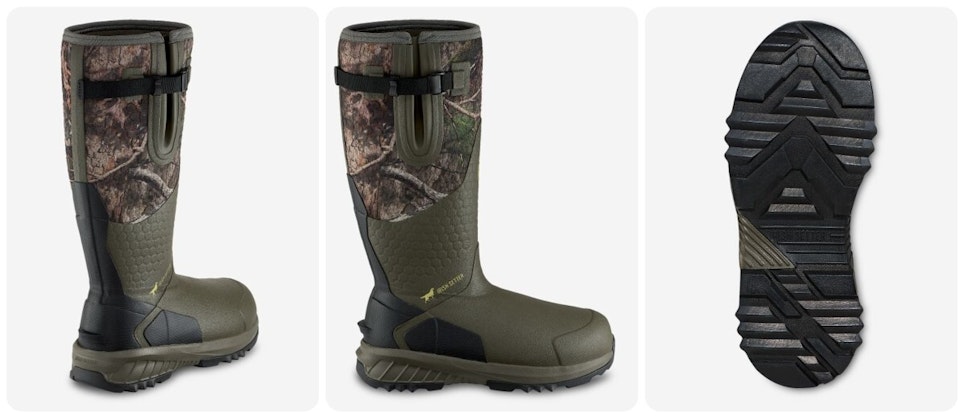
The Mudtrek 4904 (MSRP: $219.99) is similar to the 4903 but has some important differences. First, it has 1,200-gram PrimaLoft Insulation for keeping your feet warm during cold hunts. It also has what Irish Setter calls a “full fit,” which means a wider leg and ankle opening. Truth be told, I didn’t notice a big difference between the 4903’s athletic fit and the 4904’s full fit. My ankle was held in place with both versions, and my foot didn’t slip while hiking, either. That said, the 4904 has an adjustable gusset at the top, and combined with the wider leg opening, it’s easy to slide pant legs into the 4904 regardless of clothing choice.
Perhaps the most surprising — and impressive — takeaway from my field test was how warm the 4904s were, even in single digit temperatures. In the past, I would change to a winter pac boot when temps dropped below 30 degrees because my feet would get cold (sitting still for 3-4 hours after hiking to the stand). During 2022, I had pac boots on-hand and was ready to wear them. The first day with morning temps in the high 20s, I wore a thick wool sock inside of the 4904s and expected to experience cold feet. Didn’t happen. So I conducted the same experiment the following morning when temps dipped to 15. My feet were still comfortable while sitting on stand. I finally tried the 4904s with a morning temp of only 5 degrees. My feet started to get cold after 2 hours on stand. However you look at it, this is impressive for a knee-high rubber boot.
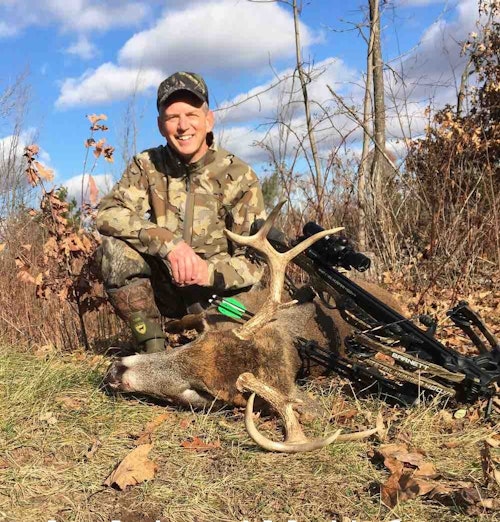
I commented earlier on the 4903’s outsole; the 4904 shares the same Aggressive Rubber Mudder outsole. I spent much of November hunting with the 4904 on snow in South Dakota and Wisconsin, and performed very well, even on steep terrain. Hiking in the 1,200-gram 4904 was easier than expected because the boots weigh only 5 pounds, 2 ounces, which is less than similarly insulated models from competitors.
Because the 4904s kept my feet warm even in temps well below freezing, I was able to access certain treestands in South Dakota that require crossing a creek. During most Novembers and Decembers, the surface of the creek doesn’t freeze solid enough to walk on the ice; I have to slowly wade through the 6- to 12-inch-deep flowing water; the creek is about 15 feet wide. During past years, when I had to wear pac boots when temps dipped into the 20s or lower, I had to switch boots at the creek in order to avoid wet feet. I would wear knee-high rubber boots to cross the creek, then change into pac boots for sitting in my treestand, then repeat the process when hiking back to my truck. Big hassle.
Final Thoughts
As I put the finishing touches to this review, and thought about whether I’ve failed to mention anything, I remembered what might be the top endorsement I can offer regarding the Irish Setter Mudtrek boots: By late-October of the 2022 deer season, two friends whom I hunt with the most in South Dakota and Wisconsin had both purchased Mudtreks. One bought the 1,200-gram 4904, and one bought both the 4903 and 4904.
